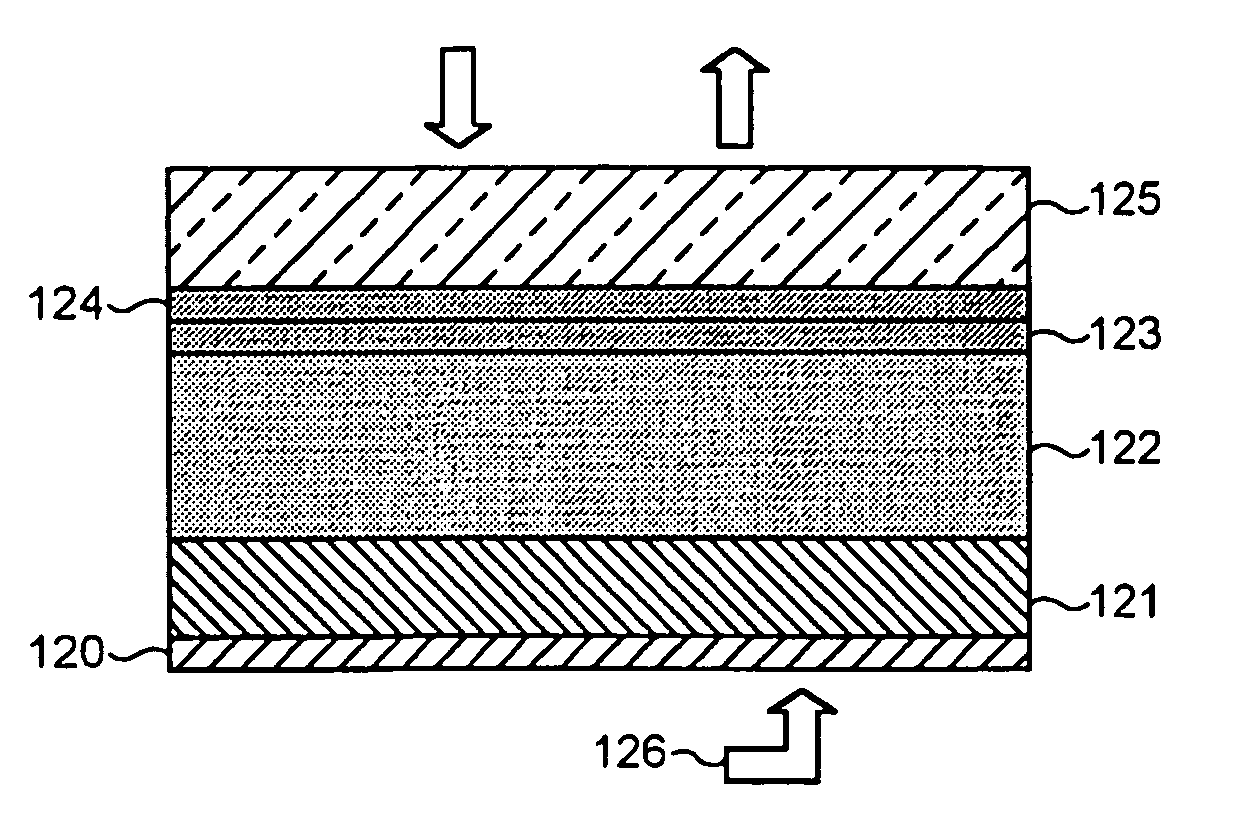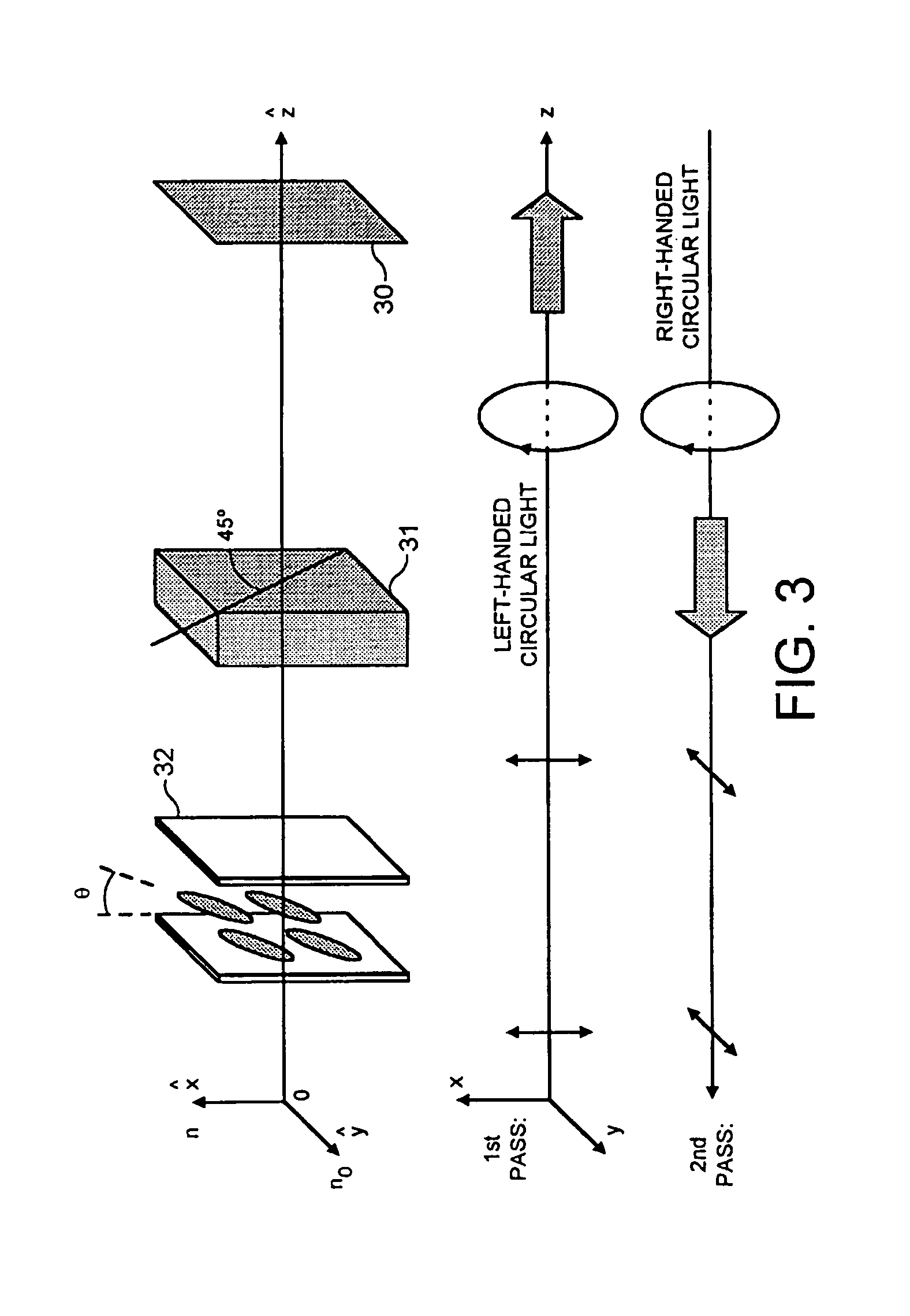Optical switch including two integrated multiphase SLM's and a wave-plate the wave-plate providing an optical retardance of (2n+1)lambda/4
a multi-phase, optical retardance technology, applied in the field of optical switching, can solve the problems of limited switching for achieving the required switching, relatively poor noise performance, and only 40.5% of the theoretical diffraction efficiency of a binary phase devi
- Summary
- Abstract
- Description
- Claims
- Application Information
AI Technical Summary
Benefits of technology
Problems solved by technology
Method used
Image
Examples
first embodiment
[0079]Referring now to FIG. 4, an integrated spatial light modulator in accordance with the invention will now be described:
[0080]AS seen in FIG. 4, the SLM consists of an aluminium pad 120, which forms a pixel array, and is connected to pixel driving circuitry by a connection figuratively shown at 126. On the pixel array 120 there is disposed a quarter-wave plate 121. On the quarter-wave plate, and over an intervening alignment layer, (not shown) there is disposed a liquid crystal layer 122—here a nematic liquid crystal is used, but the invention is not so limited. The actual requirement is the ability to provide an out of plane tilt. On the liquid crystal layer there is disposed an alignment layer 123, as known to those skilled in the art, and over the alignment layer there is disposed a transparent conductive layer 124 such as an ITO (Indium Tin Oxide) layer forming a common electrode plane, and an upper glass layer 125.
[0081]The quarter-wave plate can be deposited on the pixel a...
second embodiment
[0082]A second embodiment is shown in FIG. 5.
[0083]Referring to FIG. 5, a pixel array 130 is integrated on a silicon-1.5 μm-transparent backplane structure 131, and is sandwiched between the backplane structure and one face of a liquid crystal layer 132. The other side of the liquid crystal layer 132 is in contact with an alignment layer 133, which in turn is covered by an ITO layer 134. A quarter wave-plate 135 is disposed between a front aluminium mirror 136 and the ITO electrode 134. The thickness of the quarter wave plate may be adjusted by spin-coating techniques so that in reflection it functions as a half-wave plate at λ=1.57 μm.
[0084]An embodiment of a spatial light modulator in accordance with FIG. 5 was constructed. The pixels were constructed using the polysilicon layer of a conventional 2 μm CMOS process. FIG. 6 shows an overview of the silicon backplane layout.
[0085]Referring to FIG. 7 a further embodiment of the invention uses a twisted nematic liquid crystal mixture i...
third embodiment
[0107]Referring to FIG. 13, an optical switch according to the invention has the second SLM 141 offset by half a hologram's width in one plane (e.g. the x direction). Thus zero-order crosstalk 145, including the polarisation-dependent zero order, is directed at a point midway 149 between output fibres. In this case the zero-order crosstalk is subject to an offset of s / 2, with a corresponding additional attenuation dependent on the offset.
[0108]The third embodiment is most appropriate in the presence of good surface flatness on the SLM. For the case of offset loss, it reduces as the ratio of the spot-size to the fibre separation is increased. In any final design there will be an optimum value of this ratio to obtain the overall required system performance.
[0109]Referring now to FIG. 14, in a further embodiment a further reduction of the zero order is achieved by offsetting the output SLM 141 with respect to the input SLM 140 by a whole SLM's height (or more) in the direction normal t...
PUM
| Property | Measurement | Unit |
|---|---|---|
| optical retardance | aaaaa | aaaaa |
| voltage | aaaaa | aaaaa |
| deflection angle | aaaaa | aaaaa |
Abstract
Description
Claims
Application Information
 Login to View More
Login to View More - R&D
- Intellectual Property
- Life Sciences
- Materials
- Tech Scout
- Unparalleled Data Quality
- Higher Quality Content
- 60% Fewer Hallucinations
Browse by: Latest US Patents, China's latest patents, Technical Efficacy Thesaurus, Application Domain, Technology Topic, Popular Technical Reports.
© 2025 PatSnap. All rights reserved.Legal|Privacy policy|Modern Slavery Act Transparency Statement|Sitemap|About US| Contact US: help@patsnap.com



